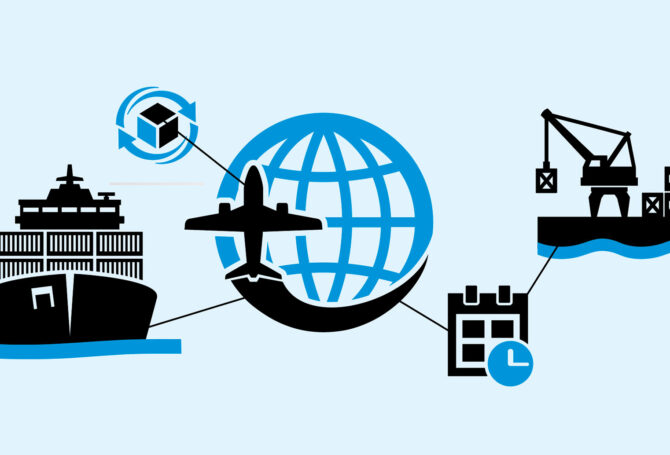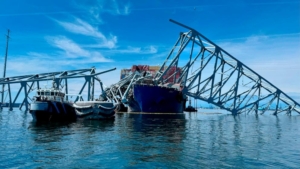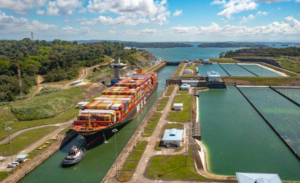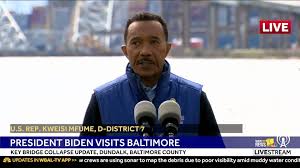
Smooth Sailing Can Keep Prices Lower, Disruptions Can Lead to Higher Prices
As much as voter attitudes turn on the price of gas at the pump and eggs in the market, economies turn on smooth-running supply chains. As the Covid-19 pandemic illustrated, when supply and demand get out of whack because of supply chain disruptions, shortages abound and prices skyrocket. Inflation is its natural child.
 In a recent column, economist Paul Krugman addressed the impact of supply chain disruptions. He cited data showing supply chain disruptions were responsible for pandemic-era inflation and restored supply chain efficiency resulted in a sharp drop of inflation.
In a recent column, economist Paul Krugman addressed the impact of supply chain disruptions. He cited data showing supply chain disruptions were responsible for pandemic-era inflation and restored supply chain efficiency resulted in a sharp drop of inflation.
Supply chain pressures (plus the interaction of these pressures with demand) accounted for most of the rise in inflation above the Fed’s 2 percent target during the past several years,” Krugman says. “Conversely, the model says that the easing of supply-chain problems as businesses adapted to economic change accounts for most of the disinflation since 2022.”
Krugman, like many others, underestimated the inflationary impact of supply chains on supply and demand. “I think it’s fair to say that a great majority of economists were caught flat-footed one way or another by inflation developments over the past three years,” he wrote. “Along with many others, I failed to predict the big initial run-up in inflation.”
He noted the U.S. economy recovered from high inflation without a depression or rising unemployment, despite predictions by doomsayers. Data shows, Krugman says, that supply chain pressures mismatched with demand accounted for most of the rise in inflation above the Fed’s 2 percent target during the past several years. Likewise, improving supply chain efficiency explains the economy’s soft landing and disinflation since 2022, according to Krugman.
“If you think supply-chain disruptions were the main driver of inflation and the easing of these disruptions the main driver of disinflation, you have to be worried about the effects of a rene“ewed worsening of the supply-chain situation,” Krugman says. Supply chains aren’t as disrupted as before, but he adds, “Supply chains are making me nervous again.” On cue, inflation ticked up slightly in March.
“Supply chains aren’t as disrupted as before,
but they are making me nervous again.”
New Supply Chain Disruptions
Supply chain disruptions have many causes. A bird flu epidemic requires a mass kill-off of chickens, impacting egg markets and egg prices. Work stoppages at ports or factories delay movement of goods, creating shortages and inflated prices. Oil refineries shut down for maintenance and supplies are temporarily curtailed, putting upward pressure on gas prices.
In a global economy, free-flowing international commerce is vital to sustaining stable markets and prices. But that commerce depends in large part on critical shipping lanes like the Suez Canal, Panama Canal and South China Sea, all of which are facing disruptive activity.
Ship travel in the Red Sea has been disrupted by Houthi drone attacks, forcing some shippers to re-route cargo vessels the long way around the Horn of Africa. Ships passing through the Panama Canal have restricted loads because of low water, a byproduct of warmer weather from climate change. Passage in the South China Sea can be sketchy as China continues to assert its claim to important shipping lanes between the Pacific Rim and South Asia.
 And then a fully loaded container ship the size of the Eiffel Tower toppled the Francis Scott Key Bridge, blocking maritime traffic to and from the Port of Baltimore, one of the nation’s busiest ports. In 2023, more than 52 million tons of cargo moved through the port, including vehicles, farm implements, textiles, metals, pharmaceuticals, animal feed and newsprint. The port also is a departure or arrival point last year for 440,000 cruise ship passengers.
And then a fully loaded container ship the size of the Eiffel Tower toppled the Francis Scott Key Bridge, blocking maritime traffic to and from the Port of Baltimore, one of the nation’s busiest ports. In 2023, more than 52 million tons of cargo moved through the port, including vehicles, farm implements, textiles, metals, pharmaceuticals, animal feed and newsprint. The port also is a departure or arrival point last year for 440,000 cruise ship passengers.
Fragile Supply Chains
The accident on the Patapsco River underscores the fragility of bridges – and supply chains. Fragility is not reserved for just waterborne supply chains. Train explosions or derailments, bridge washouts or road closures and major pipeline failures can disrupt land-based supply chains.
 “Supply chain problems today aren’t remotely as bad as they were in 2021-22,” Krugman says. “If the Dali disaster had occurred back then, it really would have been a collapsed bridge too far. According to the New York Fed measure, we’ve actually been experiencing a stretch of below-normal supply pressure, and all that has happened is a return to [pre-pandemic] normal.”
“Supply chain problems today aren’t remotely as bad as they were in 2021-22,” Krugman says. “If the Dali disaster had occurred back then, it really would have been a collapsed bridge too far. According to the New York Fed measure, we’ve actually been experiencing a stretch of below-normal supply pressure, and all that has happened is a return to [pre-pandemic] normal.”
While the Patapsco River channel is being cleared of bridge debris, the Port of Baltimore is coping by rerouting cargo on trains and trucks. Cruise ships are landing and disembarking from alternate ports. “This might not have much adverse effect on inflation,” Krugman predicts.
But the combined effect of multiple supply chain disruptions could re-ignite inflationary pressures, he warns.
Supply Chain Outlook
The Iranian-backed Houthi rebels in northern Yemen are continuing drone and missile attacks on ships in the Red Sea and Gulf of Aden. U.S. forces have managed to down most Houthi drones and missiles, but haven’t succeeded in stopping their attacks or eliminating their arsenals.
The continuing threat has led to diversion of cargo around the Cape of Good Hope, adding miles, up to 14 days and higher costs to re-routed goods. The extra travel time has disrupted shipping schedules. Some cargoes have been shifted to air freight, putting more pressure on the capacity of air shippers.
“We expect to see an air freight surge for manufacturing as automotive, electronics and other supply chains assess their inventory needs,” says Marc Schlossberg, executive vice president at Unique Logistics International.“ The situation will get worse the longer without a resolution to the war in Gaza, logistics official predict.
 Load limitations in the Panama Canal were extended into 2024 because of continued low-water levels at Gatun Lake. Trade between China, Japan, South Korea and regions of the United States is impacted as 46 percent of contained shipments from northeastern Asia to U.S. ports goes through the canal.
Load limitations in the Panama Canal were extended into 2024 because of continued low-water levels at Gatun Lake. Trade between China, Japan, South Korea and regions of the United States is impacted as 46 percent of contained shipments from northeastern Asia to U.S. ports goes through the canal.
So far, the delays and diversions haven’t been too serious, but could become problematic later this year when holiday-related shipments increase. Disruptions would have repercussions on distribution centers, fulfillment centers and retail stores.
The South China Sea has become a proxy war zone between China and U.S. Pacific Rim allies. China had combat patrols trolling U.S.-led war games including Japan, Australia, Vietnam, and Taiwan. The Philippines and China have traded heated accusations over possession of islands and control of maritime lanes.
Port of Baltimore
 President Biden has promised the federal government will pay the lion’s share of the cost to clean up debris and rebuild the Francis Scott Key Bridge. Clearing shipping channels and refloating the damaged container ship is expected to take weeks.
President Biden has promised the federal government will pay the lion’s share of the cost to clean up debris and rebuild the Francis Scott Key Bridge. Clearing shipping channels and refloating the damaged container ship is expected to take weeks.
To keep Biden’s promise will require congressional spending approval. Some members are already balking at footing the entire bill, asserting the ship owner and insurance coverage should be tapped first.
Maryland Democratic Congressman Steny Hoyer, formerly the No. 2 House Democrat, said relief for Baltimore “isn’t an act of charity” but “an investment that is absolutely essential to preserving the integrity of the entire American economy.”
Pennsylvania Republican Congressman Dan Meuser questioned whether the federal government should pay the entire freight to replace the bridge. He called Biden’s pledge a “knee-jerk” response to a crisis, not an actual plan of action.
 Maryland Democratic Congressman Kweisi Mfume, whose district includes the bridge, called Meuser’s financial reticence “short-sighted”. He said Meuser, co-chair of the Congressional Coal Caucus, may be unaware that one of the main exports out the Port of Baltimore is coal.
Maryland Democratic Congressman Kweisi Mfume, whose district includes the bridge, called Meuser’s financial reticence “short-sighted”. He said Meuser, co-chair of the Congressional Coal Caucus, may be unaware that one of the main exports out the Port of Baltimore is coal.
“This is not a Chesapeake Bay, Baltimore issue, “Mfume says. “It affects the supply chains nationwide and will have an impact economically nationwide unless that bridge is rebuilt.”




